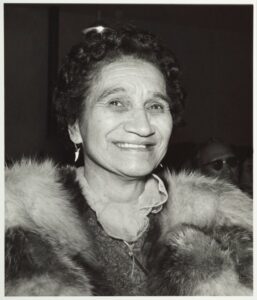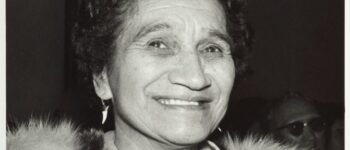1951: The Rise of Whina Cooper
November 19, 2024
By AHNZ
 Josephine ‘Whina’ Gilbert (Later Whina Cooper) had been a big shot in the Hokianga. For example, in roles unusual for a woman, she was president both of her local Federated Farmers branch and of the North Hokianga Rugby Union. The Maori journal The New World said of Whina that she had “an “afraid of no one” complex.” Before dropping out of school, for example, she tried to show off by diving from the highest diving board available. But her massive ego had bitten off more than her ability could handle. When the girl came spluttering from the deep end she was sick for many days after. Ref. The New World/Te Ao Hou (1955,) Papers Past
Josephine ‘Whina’ Gilbert (Later Whina Cooper) had been a big shot in the Hokianga. For example, in roles unusual for a woman, she was president both of her local Federated Farmers branch and of the North Hokianga Rugby Union. The Maori journal The New World said of Whina that she had “an “afraid of no one” complex.” Before dropping out of school, for example, she tried to show off by diving from the highest diving board available. But her massive ego had bitten off more than her ability could handle. When the girl came spluttering from the deep end she was sick for many days after. Ref. The New World/Te Ao Hou (1955,) Papers Past
Whina, with her first husband, became the leading capitalists of the Northern Hokianga. This possible thanks to recognition and financial capital of Dutch Catholic Priest Charles Kreymborg who saw the potential and lifted the family of of poverty. During George Forbes’ Ministry, in 1932, Apirana Ngata pumped Whina full of government money and she became a national figure. “The Amazon Excavator,” Cooper, was the Tzar responsible for scores of workers and tens of thousands of acres of wasteland being brought into productive use in her districts. The same work that her friend Princess Te Puea was engaged in. Ngata, in 1934, would be found guilty by Royal Commission for throwing money around without adequate accounting and his political career was ended in scandal. But the future Mrs Cooper was all in the clear! She also succumbed to hypergamy by taking one of Ngata’s officials as a lover. A married man named William Cooper. While pregnant with his child, her old farmer husband became sick and died. It was a scandal. And, a betrayal of the Church that had lifted Whina up from obscurity.
“Cooper consulted frequently and their relationship became a courtship. This coincided with a decline in Richard Gilbert’s health as a consequence of cancer. When Gilbert died in March 1935 Whina was pregnant to Cooper. She announced this at a hui in Panguru and said that they intended to marry as soon as Cooper was able to obtain a divorce. The community reaction was one of shock and anger. Whina was not only challenging the customs of a Māori rural community, but she was doing so as a pillar of the Catholic church. ” – Encyclopedia of New Zealand (2000)
“Some of those members were now voicing reservations about Whina’s growing inclination to act without consulting her executive and her assumption that she would remain president for life. The following year she was persuaded to step down and the annual conference rewarded her with the title Te Whaea o te Motu (Mother of the Nation).” – ibid
“Apirana was coming to the Hokianga. There he met all the people at Panguru and explained that he had come to take them up on Whina’s boast. He told the people he had come with the “man in charge of the money bag.” How much did Panguru want? So land development began in the Hokianga. And the work went with a swing. Mrs Cooper still regards “the Old Man” with affection—really hero worship. She worked on his schemes, listend eagerly for his advice, took in all. She knew the Hokianga lands intimately, consequently she acted, in a way, as Sir Apirana surveyor. In Panguru a gang of 80 did community farm work, from one farm to the next—clearing, fencing, drainage.” – Te Ao Hou (1955)
![]() In 1951 Mr Cooper had died and Whina, now a grandmother, decided to join in with The Second Great Migration. And, lead it. She moved to Grey Lynn, Auckland. In doing so, she sold her (Maori) land in exactly the same way she would, in the 1970s, insist Maoris must never do. She instantly became, rather than a tribal leader, a national figure as first president of Maori Women’s Welfare League. This was a government-funded league focused on community, education, and health initiatives for urban Maori women and children during this time of the Great Migration. But Cooper’s big ego took over and she became synonymous with the League, ruling it autocratically. Cooper was pushed out in 1957 by which time the organisation was in free fall; The lightning had escaped from the bottle.
In 1951 Mr Cooper had died and Whina, now a grandmother, decided to join in with The Second Great Migration. And, lead it. She moved to Grey Lynn, Auckland. In doing so, she sold her (Maori) land in exactly the same way she would, in the 1970s, insist Maoris must never do. She instantly became, rather than a tribal leader, a national figure as first president of Maori Women’s Welfare League. This was a government-funded league focused on community, education, and health initiatives for urban Maori women and children during this time of the Great Migration. But Cooper’s big ego took over and she became synonymous with the League, ruling it autocratically. Cooper was pushed out in 1957 by which time the organisation was in free fall; The lightning had escaped from the bottle.
Now 62, Cooper was the most famous Maori woman in New Zealand. People thought she was done. Yet in 1975, aged 80, Josephine powered up again for her last big play for national recognition. The Maori Land March. She cobbled together various factions with a view to once again becoming the Amazon Excavator but this time of legislation. She was going to be a powerful kingmaker at parliament bringing men like Muldoon to heel, re-writing the laws that hurt her people. At least that was the plan. Unfortunately her base crumbled when it found out what she was really up to.
The chieftainess died 26 March 1994, aged 98. I think she would laugh today, though it would delight her ego, to find that she has been erected on a stick! Cooper has been made into a big yellow roads sign to warn drivers they are near a Maori town hall (Marae.) It is an excellent symbol both of day 1 of the Land March and Cooper’s role for women and children in the 1950s. However, it is highly dubious as to why the national road code needed to change to accommodate one woman’s career. Ref. 2021: Marae Pedestrian Warning Sign, AHNZ
—
Image ref. Cooper in her fine furs, Ans Westra, Museum of New Zealand
Image ref. Josephine ‘Whini’ Cooper and grandaughter Irene Cooper. NZ Herald (1975)
2 thoughts on "1951: The Rise of Whina Cooper"
Leave a Reply
 Like Comment Share
Like Comment Share






Either way, she was some woman. Great article
Top tier. More to come